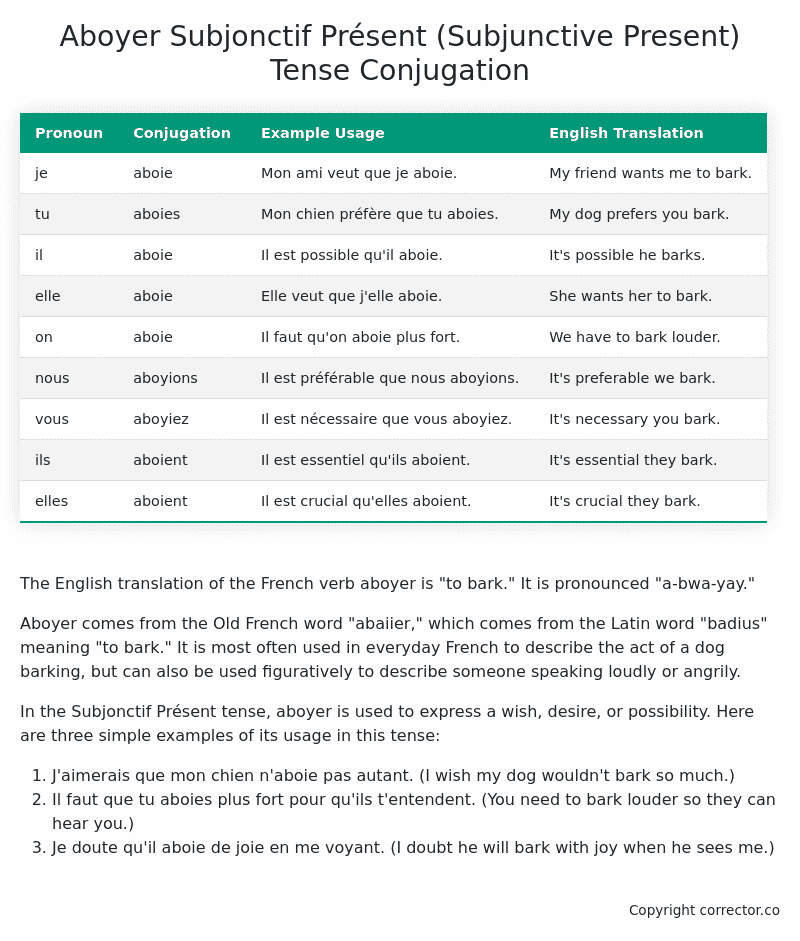Subjonctif Présent (Subjunctive Present) Tense Conjugation of the French Verb aboyer
Introduction to the verb aboyer
The English translation of the French verb aboyer is “to bark.” It is pronounced “a-bwa-yay.”
Aboyer comes from the Old French word “abaiier,” which comes from the Latin word “badius” meaning “to bark.” It is most often used in everyday French to describe the act of a dog barking, but can also be used figuratively to describe someone speaking loudly or angrily.
In the Subjonctif Présent tense, aboyer is used to express a wish, desire, or possibility. Here are three simple examples of its usage in this tense:
- J’aimerais que mon chien n’aboie pas autant. (I wish my dog wouldn’t bark so much.)
- Il faut que tu aboies plus fort pour qu’ils t’entendent. (You need to bark louder so they can hear you.)
- Je doute qu’il aboie de joie en me voyant. (I doubt he will bark with joy when he sees me.)
Table of the Subjonctif Présent (Subjunctive Present) Tense Conjugation of aboyer
| Pronoun | Conjugation | Example Usage | English Translation |
|---|---|---|---|
| je | aboie | Mon ami veut que je aboie. | My friend wants me to bark. |
| tu | aboies | Mon chien préfère que tu aboies. | My dog prefers you bark. |
| il | aboie | Il est possible qu’il aboie. | It’s possible he barks. |
| elle | aboie | Elle veut que j’elle aboie. | She wants her to bark. |
| on | aboie | Il faut qu’on aboie plus fort. | We have to bark louder. |
| nous | aboyions | Il est préférable que nous aboyions. | It’s preferable we bark. |
| vous | aboyiez | Il est nécessaire que vous aboyiez. | It’s necessary you bark. |
| ils | aboient | Il est essentiel qu’ils aboient. | It’s essential they bark. |
| elles | aboient | Il est crucial qu’elles aboient. | It’s crucial they bark. |
Other Conjugations for Aboyer.
Le Present (Present Tense) Conjugation of the French Verb aboyer
Imparfait (Imperfect) Tense Conjugation of the French Verb aboyer
Passé Simple (Simple Past) Tense Conjugation of the French Verb aboyer
Passé Composé (Present Perfect) Tense Conjugation of the French Verb aboyer
Futur Simple (Simple Future) Tense Conjugation of the French Verb aboyer
Futur Proche (Near Future) Tense Conjugation of the French Verb aboyer
Plus-que-parfait (Pluperfect) Tense Conjugation of the French Verb aboyer
Passé Antérieur (Past Anterior) Tense Conjugation of the French Verb aboyer
Futur Antérieur (Future Anterior) Tense Conjugation of the French Verb aboyer
Subjonctif Présent (Subjunctive Present) Tense Conjugation of the French Verb aboyer (this article)
Subjonctif Passé (Subjunctive Past) Tense Conjugation of the French Verb aboyer
Subjonctif Imparfait (Subjunctive Imperfect) Tense Conjugation of the French Verb aboyer
Subjonctif Plus-que-parfait (Subjunctive Pluperfect) Tense Conjugation of the French Verb aboyer
Conditionnel Présent (Conditional Present) Tense Conjugation of the French Verb aboyer
Conditionnel Passé (Conditional Past) Tense Conjugation of the French Verb aboyer
L’impératif Présent (Imperative Present) Tense Conjugation of the French Verb aboyer
L’infinitif Présent (Infinitive Present) Tense Conjugation of the French Verb aboyer
Struggling with French verbs or the language in general? Why not use our free French Grammar Checker – no registration required!
Get a FREE Download Study Sheet of this Conjugation 🔥
Simply right click the image below, click “save image” and get your free reference for the aboyer Subjonctif Présent tense conjugation!

Aboyer – About the French Subjonctif Présent (Subjunctive Present) Tense
Formation of the Subjonctif Présent
Common Everyday Usage Patterns
Interactions with Other Tenses
Summary
I hope you enjoyed this article on the verb aboyer. Still in a learning mood? Check out another TOTALLY random French verb conjugation!


